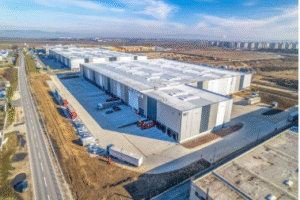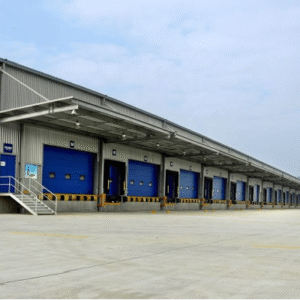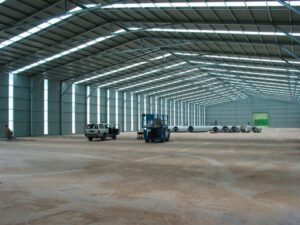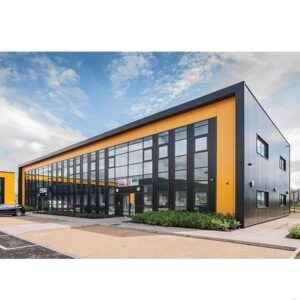Blog

Why Partially Occupied Industrial Properties Represent Unique Investment Opportunities
In the world of real estate investing, industrial properties have long been recognized for their stability and income-generating potential. However, one niche segment is increasingly catching the attention of savvy investors: partially occupied industrial properties.

What Is a Multi-Tenant Industrial Property and Why Is It on the Rise
As demand continues to grow for flexible, cost-efficient spaces in the industrial real estate sector, multi-tenant industrial properties are emerging as a preferred choice for both tenants and investors. But what exactly are these properties, and why are they becoming so popular?

5 Reasons Why Selling Your Industrial Property Directly to a Private Group Is More Profitable
If you’re thinking about selling your industrial property, you may assume that listing it with a broker or going through a lengthy marketing process is the best—or only—option. But in today’s fast-moving market, many property owners are discovering that selling directly to a private investment group is not only faster, but often more profitable.

How to Assess Risk and Return in Commercial Properties Between 15,000 and 120,000 SF
Investing in commercial real estate can be highly rewarding, but it comes with inherent risks—especially when dealing with properties in the 15,000 to 120,000 square foot range. These mid-sized assets are common in industrial, flex, and retail markets, and they attract a diverse group of investors, from local operators to institutional buyers. Understanding how to assess both risk and return is critical for making informed decisions.

Cap Rate vs. Cash-on-Cash: How to Properly Analyze Commercial Real Estate
When analyzing commercial real estate deals, two financial metrics dominate investor conversations: Cap Rate and Cash-on-Cash Return. While both are essential tools for evaluating investment potential, they measure very different things. Misunderstanding or misapplying them can lead to poor investment decisions.

Strategic Investment in Buffalo and Syracuse, NY: What’s Driving the Industrial Market
Upstate New York is undergoing an industrial transformation. Two cities stand out in this shift: Buffalo and Syracuse. Both markets are drawing increasing interest from national and regional investors, thanks to strategic infrastructure development, public-private partnerships, and surging demand in advanced manufacturing and logistics

Industrial Market Trends in the Northeastern U.S. Investors Should Watch in 2025
The industrial real estate market across the Northeastern U.S. is evolving rapidly. From last-mile logistics shifts to onshoring-fueled manufacturing growth, the region is seeing dynamic demand—and 2025 is shaping up to be a pivotal year. For commercial property investors, understanding the key trends driving this market is essential for smart capital deployment.

Common Mistakes New Investors Make in Commercial Real Estate
Commercial real estate (CRE) offers strong long-term returns, but it’s not without risks—especially for new investors. Whether you’re buying your first retail strip, warehouse, or flex space, the learning curve can be steep. Avoiding common pitfalls early can save you time, money, and headaches down the line.

Industrial Real Estate Outlook in Connecticut: Opportunities to Sell or Invest
Connecticut’s industrial sector continues to demonstrate robust demand, rising rents, and limited supply, making it a compelling target for both sellers and investors. Here’s a detailed outlook.
Let’s break down how each metric works—and how to use them together to make smarter commercial real estate decisions.

What Institutional Buyers Look for in 15,000 to 120,000 SF Industrial Properties
The industrial real estate market is experiencing a significant shift. Institutional buyers—once focused primarily on large-scale logistics hubs—are increasingly eyeing mid-sized properties ranging from 15,000 to 120,000 square feet. These assets offer strong upside potential in supply-constrained markets and serve a critical role in the evolving supply chain. But what exactly are these investors looking for when evaluating assets in this size range?

Tax Advantages of Investing in Industrial Properties Through 1031 Exchange Structures
For savvy real estate investors, 1031 exchanges have long been a powerful tool to build wealth, defer taxes, and reposition portfolios. When applied to industrial properties, especially in today’s competitive market, the advantages become even more compelling.
Whether you’re trading up from a small facility or diversifying into mid-sized industrial assets (15,000–120,000 SF), here’s how a 1031 exchange can maximize your returns and preserve capital

New Hampshire: An Emerging Market for Mid-Sized Industrial Properties
As institutional investors widen their scope in search of strong industrial returns, one state is quietly making waves: New Hampshire. Traditionally overshadowed by larger Northeast markets like Boston or Northern New Jersey, New Hampshire is now gaining attention as a high-potential hub—especially for mid-sized industrial assets between 15,000 and 120,000 square feet.
Here’s why New Hampshire is becoming an emerging market worth watching.
Here are the most frequent mistakes new CRE investors make—and how to avoid them.
Let’s break down how each metric works—and how to use them together to make smarter commercial real estate decisions.

How to Maximize the Value of Your Commercial Property Before Selling
Selling a commercial property is more than just putting it on the market and hoping for the best offer. Whether you own a 20,000 SF warehouse or a 100,000 SF retail center, there are strategic steps you can take to increase your property’s value—and your ultimate return—before closing the deal.
Here’s how to position your property for maximum value and attract serious, qualified buyers.

The Importance of Due Diligence in Partially Occupied Commercial Properties
Investing in partially occupied commercial real estate can be a smart move—offering both immediate income from current tenants and the opportunity to boost value through strategic lease-up. But beneath the surface, these properties often carry layers of risk and complexity that can impact everything from financing to long-term asset performance.
That’s why due diligence isn’t just important—it’s essential.
Here’s how to position your property for maximum value and attract serious, qualified buyers.

Is Your Property Ready to Be Sold? A Checklist for Owners
Before listing your commercial property, make sure it’s market-ready. From lease audits to updated photos, the right prep can speed up your sale and boost your property’s value.
This quick checklist covers everything buyers (and their lenders) want to see—so you can sell with confidence.

Why Pennsylvania Is a Hotspot for Industrial Warehouse Investment
As demand for efficient logistics, manufacturing, and last-mile delivery continues to soar, Pennsylvania has emerged as one of the most attractive states for industrial warehouse investment in the U.S. With strategic location, strong infrastructure, a business-friendly climate, and growing tenant demand, it’s no surprise that investors are increasingly focused on this key Northeast market.
At CommercialGrp, we specialize in sourcing and analyzing mid-sized industrial assets across Pennsylvania—particularly in the 15,000 to 120,000 square foot range. Here’s why this state stands out as a hotbed for industrial investment.

How Commercial GRP Identifies Off-Market Opportunities for Its Investors
In commercial real estate, the best deals often never hit the market. These off-market opportunities are typically more flexible, less competitive, and offer significant upside—but they’re not easy to find.
At Commercial GRP, sourcing off-market properties is one of our core strengths. It’s how we deliver exceptional value to our investors and stay ahead of the competition in the fast-moving world of industrial and commercial real estate.
Here’s how we do it:

What to Consider Before Investing in Industrial Properties in Massachusetts or Rhode Island
Investing in industrial real estate can be a powerful way to build long-term wealth—but like any investment, success starts with choosing the right market and the right strategy. For investors exploring opportunities in Massachusetts or Rhode Island, there’s strong potential—but also a few key considerations to keep in mind.
At Commercial GRP, we specialize in helping investors evaluate markets, uncover off-market opportunities, and build portfolios across New England. If you’re eyeing industrial properties in these two states, here’s what you should know before diving in

Profitability Comparison: Commercial Properties in MA vs. RI vs. NH
When it comes to investing in commercial real estate across New England, Massachusetts (MA), Rhode Island (RI), and New Hampshire (NH) each offer unique opportunities—and challenges. But which state offers the best profitability for investors?
At Commercial GRP, we work across all three markets and help investors navigate local dynamics to maximize returns. Here’s a breakdown of how they compare in terms of rents, cap rates, taxes, demand, and long-term upside.

What Is Industrial Real Estate and Why Is Demand Still Strong?
As demand continues to grow for flexible, cost-efficient spaces in the industrial real estate sector, multi-tenant industrial properties are emerging as a preferred choice for both tenants and investors. But what exactly are these properties, and why are they becoming so popular?
Let’s break it down.

How to Accurately Value Your Industrial Building in Today’s Market
If you’re thinking about selling your industrial property—or just curious about its value—you’re not alone. With the demand for industrial real estate still high in many U.S. markets, property owners are increasingly asking: “How much is my industrial building really worth?”
The truth is, no two industrial properties are exactly alike, and the market is constantly shifting. But there are proven ways to estimate value accurately and confidently—without relying solely on broker opinions or automated online tools.
In this article, we’ll break down the key factors that determine what your property is worth today, and how you can get a reliable valuation before going to market.

Understanding Cap Rates: What’s Fair for Industrial Properties in 2025?
If you’re considering selling or investing in industrial real estate, you’ve likely come across the term “cap rate.” But what exactly is a cap rate—and how do you know what’s fair in today’s market?
Whether you own a single-tenant warehouse or a multi-tenant light industrial property, understanding cap rates is essential for accurately pricing, buying, or evaluating any deal in 2025.
In this article, we’ll break down what a cap rate is, how it’s used to value industrial properties, and what sellers and investors should expect in today’s market environment.

How to Sell a Fully or Partially Leased Industrial Property Without Disrupting Tenants
If you own a warehouse or industrial property that’s currently leased, you might be wondering:
Can I sell this building without disrupting my tenants or losing rental income?
The answer is yes—and with the right strategy, it can be one of the most seamless (and profitable) ways to sell commercial real estate.
In fact, selling a fully or partially leased industrial property often makes it more attractive to buyers, especially investors seeking in-place cash flow from day one. However, it requires careful planning, clear communication, and a market-savvy sales approach.
Let’s break down how to do it right.

5 Ways to Find Off-Market Industrial Properties Before Anyone Else
If you’re tired of competing with dozens of buyers on every listed industrial property, you’re not alone. In today’s high-demand, low-inventory market, many of the best deals never hit the open market.
Off-market industrial properties—those sold quietly without public listings—offer serious advantages:
- Less competition
- Direct negotiation with motivated sellers
- Potential for better pricing or terms
But how do you actually find these off-market opportunities?
At CommercialGrp.com, we specialize in helping investors and brokers uncover industrial assets before they go public. Below, we’re sharing five proven strategies to help you find your next deal—before the rest of the market even knows it exists.

Selling Commercial Real Estate Held in an LLC: What You Should Know
If you own a commercial property through a Limited Liability Company (LLC), you might be wondering:
Can I sell my property if it’s held in an LLC?
The short answer: Yes, you can—and in many cases, selling through an LLC can provide both flexibility and tax benefits. But there are a few key legal, financial, and practical considerations you should understand first.
Whether you’re thinking about selling an industrial building, retail center, or office asset, this guide will help you understand how the LLC structure impacts the sale—and how to prepare for a smooth transaction.

How to Use Your IRA or 401(k) to Invest in Real Estate: The Benefits of a Self-Directed IRA
If you have money sitting in a traditional IRA or an old 401(k), you might think your only options are stocks, bonds, or mutual funds. The truth is, you can use those same retirement funds to invest directly in real estate — without cashing out and paying taxes or penalties.
The key? A Self-Directed IRA (SDIRA).
What Is a Self-Directed IRA?
A Self-Directed IRA works just like a traditional or Roth IRA in terms of tax advantages, but it gives you the freedom to invest in a much wider range of assets — including rental properties, commercial buildings, vacant land, or even private real estate deals.
Unlike a standard IRA that’s limited to Wall Street products, an SDIRA puts you in control of where your retirement money goes.
.

The Smart Buyer’s Guide to Purchasing Industrial Properties Without a Broker
Industrial real estate is one of the most sought-after asset classes in today’s market. From warehouses and logistics hubs to manufacturing facilities, these properties can offer strong cash flow, long-term appreciation, and stability.
But what if you want to buy without using a broker?
At Commercial GRP, we work directly with sellers and buyers every day — and we know going broker-free can save you time and money if you know the process. This guide will walk you through how to purchase an industrial property without a broker, the benefits, and the risks to watch for.

Do Leases Transfer When You Sell? What Commercial Property Owners Must Know
If you own a commercial property with tenants in place, selling the asset involves more than just finding a buyer and signing paperwork. One of the most common questions we hear at Commercial GRP is:
“What happens to my tenants and their leases if I sell?”
The short answer: In most cases, the lease transfers to the new owner. But there’s more to it than that — and understanding how it works can help you sell smoothly, avoid legal pitfalls, and preserve the property’s value.

Off-Market Sales for Industrial Properties: What Owners Need to Know
When it comes to selling an industrial property, many owners assume listing with a broker is the only path. But in today’s market, selling off-market—directly to a buyer without putting the property on public listing platforms—has become an increasingly attractive option.
At Commercial GRP, we work directly with industrial property owners across Connecticut and beyond who are looking for a faster, more discreet way to sell. Before you decide if an off-market sale is right for you, let’s break down the pros and cons.

Top 7 Things Smart Investors Look for in Light Industrial Assets
Light industrial properties—typically between 15,000 and 120,000 square feet—are in high demand. Whether you’re a first-time investor or a small business owner looking to buy, these assets can offer stable cash flow, tenant demand, and long-term appreciation. But before you sign on the dotted line, it’s important to know what separates a strong investment from a risky one.
Here are the top 7 things smart investors look for in light industrial assets

When to Use a 1031 Exchange to Sell or Buy Industrial Real Estate
For many real estate investors, the 1031 exchange is one of the most powerful tools available to preserve wealth, defer taxes, and grow portfolios. But when it comes to industrial real estate, timing and strategy are everything. Knowing when (and how) to use a 1031 can make the difference between a smart reinvestment and a missed opportunity.

How to Sell an Industrial Building Fast (Without Cutting the Price)
Selling an industrial property—especially a warehouse—can feel like it takes forever. Owners often wonder: “Is this going to be a 6-month process? A year? Longer?” The truth is, the timeline for selling a warehouse depends on demand, location, and the type of buyers you attract. But here’s the good news: with the right strategy, you can move your property faster—without resorting to slashing your asking price.

Industrial Real Estate Outlook in Boston for 2025
Boston’s industrial real estate market has been one of the most resilient sectors in Greater Boston’s commercial landscape over the past few years. With demand from logistics, e-commerce, biotech, and life sciences, warehouse and industrial space continues to play a critical role in the region’s economy. As we enter 2025, property owners and buyers alike are asking: What’s next for industrial real estate in Boston?

How to Sell Commercial Property Without an Agent: Direct Buyer Tips
When it comes time to sell commercial property, most owners assume the only path forward is hiring a broker, listing the asset publicly, and waiting for offers. But that process can take months—and involves hefty commissions and unpredictable negotiations.
What many owners don’t realize is that you can sell commercial property directly to a buyer. In fact, for the right seller, going direct is often faster, cleaner, and more profitable.

How to Evaluate an Industrial Property for Long-Term Investment
Industrial real estate remains one of the most resilient and attractive asset classes for investors. With steady demand driven by e-commerce, manufacturing, and supply chain growth, industrial properties can offer stable cash flow and long-term value appreciation. However, selecting the right property requires careful evaluation. Here are the key factors investors should consider when assessing an industrial property for long-term investment

Top Emerging Industrial Real Estate Markets in the U.S.
The industrial real estate sector continues to thrive across the United States, fueled by e-commerce growth, reshoring of manufacturing, and increased demand for modern logistics facilities. While core markets like Los Angeles, Chicago, and Dallas-Fort Worth remain dominant, several emerging markets are quickly gaining attention from investors, developers, and tenants. Here are some of the top rising industrial real estate markets in the U.S

The Role of Location in Industrial Real Estate Value
In industrial real estate, location isn’t just a factor—it’s often the single most important driver of value. Unlike other property types where aesthetics or amenities may weigh heavily, industrial properties succeed or fail based on how efficiently they connect goods, people, and supply chains. Understanding the role of location helps investors, developers, and tenants make decisions that maximize long-term value

Comparing Industrial vs. Retail vs. Office Investments
Commercial real estate is a broad asset class, but not all property types perform the same way. Investors evaluating industrial, retail, and office properties must weigh very different demand drivers, risk profiles, and long-term returns. Understanding these distinctions is critical when building a diversified CRE portfolio.

What Tenants Look for in Industrial Properties (15K–120K SF)
When it comes to industrial real estate, tenant needs go far beyond square footage. For businesses searching in the 15,000–120,000 square foot range, functionality, efficiency, and location play critical roles in decision-making. Understanding what tenants prioritize can help owners and investors position their properties competitively in today’s market.

How Our Value-Add Strategy Turns Partially Occupied Industrial Assets Into High-Performing Investments
By Casey DiMascio, Broker Relations at CommercialGRP
At CommercialGRP, we see opportunities where others see challenges. Partially occupied industrial properties often get overlooked by investors who want the stability of fully leased assets. But for us, these properties represent one of the most effective ways to create outsized value.
Our value-add strategy is built on three pillars: targeted leasing, operational improvements, and strategic repositioning. Together, these transform underperforming assets into high-performing investments.

Why Mid-Size Industrial Real Estate (15K–120K SF) Is the Smart Investor’s Choice in 2025
By Kyle Gibbons, Acquisitions Lead at CommercialGRP
When most investors think of industrial real estate, they picture massive distribution centers—million-square-foot facilities serving Amazon or Walmart. While those assets get headlines, I believe the real opportunities in 2025 lie in mid-size industrial properties between 15,000 and 120,000 square feet. At CommercialGRP, this is our specialty, and here’s why investors should be paying attention.

The Impact of E-Commerce Growth on Industrial Real Estate Demand
E-commerce has transformed how people shop, how companies move goods, and how supply chains operate. This shift has made industrial real estate one of the most in-demand asset classes in commercial property. From massive regional distribution centers to last-mile warehouses in urban markets, the growth of online shopping continues to reshape demand patterns and investment strategies.

Why CommercialGrp Focuses on Industrial Assets—and How Investors Benefit
By Casey DiMascio, Head of Broker Partnerships, CommercialGRP
At CommercialGRP, our mission has always been clear: to create lasting value in the communities where we invest, while delivering strong returns for our investors. One of the ways we do this is by focusing on industrial assets, specifically those between 15,000 and 120,000 square feet, along with select retail properties that align with our buy box. But why industrial? And how does this focus translate into meaningful benefits for our investors and partners?

Comparing ROI: Industrial vs. Retail vs. Office Investments
By Kyle Gibbons, Head of Acquisitions, CommercialGRP
As someone who leads acquisitions at CommercialGRP, I evaluate potential deals with precision, discipline, and a focus on long-term value. One of the most common questions we receive from investors is: Which asset class provides the best returns—industrial, retail, or office? Understanding the nuances of each segment is critical for making informed investment decisions.

Passive Income Through Industrial Real Estate: How to Earn Without Managing Tenants
By Casey DiMascio, Head of Broker Partnerships, CommercialGRP
Many investors dream of generating passive income—but few enjoy the day-to-day headaches of managing residential tenants. At CommercialGRP, we help investors achieve real, predictable returns without the stress of being a landlord. How? By focusing on industrial real estate, specifically properties between 15,000 and 120,000 square feet, along with select retail properties that align with our buy box.

How Supply Chain Reshoring Is Creating Opportunities for Industrial Investors
By Kyle Gibbons, Head of Acquisitions, CommercialGRP
Many investors dream of generating passive income—but few enjoy the day-to-day headaches of managing residential tenants. At CommercialGRP, we help investors achieve real, predictable returns without the stress of being a landlord. How? By focusing on industrial real estate, specifically properties between 15,000 and 120,000 square feet, along with select retail properties that align with our buy box.

How We Select Industrial Markets With Long-Term Growth Potential
By Casey DiMascio, Head of Broker Partnerships, CommercialGRP
At CommercialGRP, our approach to industrial real estate isn’t just about acquiring properties—it’s about investing in markets that will thrive for years to come. Selecting the right location is critical to generating strong returns for investors while supporting the communities where we operate. But how do we determine which markets have long-term growth potential?

Why Industrial Real Estate Is Resilient Even in Uncertain Economic Times
By Kyle Gibbons, Head of Acquisitions, CommercialGRP
In today’s volatile economic climate, investors are increasingly focused on stability and predictability. Industrial real estate stands out as a resilient asset class, providing consistent returns even when broader markets experience uncertainty. Understanding why industrial properties maintain their value can help investors make informed decisions and confidently allocate capital.

Building Trusted Broker Partnerships to Transform Communities
By Casey DiMascio, Broker Partnerships Lead at CommercialGRP
At CommercialGRP, we know that real estate is more than numbers on a page—it’s about people, relationships, and the communities we touch. My role, leading broker partnerships, is rooted in one simple idea: when we collaborate with transparency and trust, we all create more value.

The Impact of E-Commerce Growth on Industrial Real Estate—and Why Investors Should Pay Attention
By Kyle Gibbons, Acquisitions – CommercialGRP
The rise of e-commerce has fundamentally reshaped industrial real estate. What was once a niche segment has become the backbone of supply chain infrastructure, creating unprecedented demand for well-located warehouse and distribution assets. At CommercialGRP, our acquisitions strategy is built around recognizing these shifts early, analyzing their long-term impact, and positioning our investors to benefit from this structural change.

Transparency in Action: How We Keep Investors Updated Every Step of the Way
By Casey DiMascio, Broker Partnerships – CommercialGRP
In commercial real estate, trust is everything. At CommercialGRP, we believe the foundation of that trust is built on transparency—not just at the closing table, but every step along the way. Our investors and broker partners know that when they work with us, they’ll never be left wondering where things stand.

Why Family Offices and Private Investors Are Increasing Allocations to Industrial Assets
By Kyle Gibbons, Acquisitions – Commercial GRP
Over the past decade, industrial real estate has quietly transitioned from a niche asset class to a core holding for institutional and private investors alike. What was once viewed as a low-yield, low-glamour sector is now seen as a foundation for stable, inflation-resilient portfolios. At Commercial GRP, we’re seeing this trend accelerate among family offices and private investors who are actively increasing allocations to industrial assets — and for good reason.

What It’s Like to Partner With CommercialGRP as an Investor
By Casey DiMascio, Broker Partnerships – Commercial GRP
At CommercialGRP, we believe great partnerships start with clarity and trust. Whether you’re an investor, broker, or property owner, our goal is simple: to create lasting value through transparent collaboration and disciplined execution. Having the privilege to work closely with brokers and investors every day, I’ve seen firsthand what makes our approach different — and why so many partners continue to grow with us year after year.

How Local Regulations and the MBTA Communities Act Are Changing Commercial Development
By Casey DiMascio, Lead of Broker Partnerships at CommercialGRP
Commercial development in Massachusetts is evolving — and fast. Between zoning shifts, sustainability mandates, and the rollout of the MBTA Communities Act, investors and developers are rethinking how they approach industrial and retail assets. For those of us building partnerships across the industry, understanding these changes isn’t just helpful — it’s essential.
At CommercialGRP, we view these policy updates through a lens of opportunity. Our focus remains clear: transforming communities and improving lives through thoughtful commercial investment — particularly in the industrial (15K–120K SF) and retail sectors where our expertise lies

Cap Rate Insights from the Analyzer: Where Industrial Investors Are Finding the Best Returns in MA
By Aaron Giron, Investment Analyst at CommercialGRP
In today’s industrial real estate market, understanding where investors are finding the best returns is as critical as why those returns exist. At CommercialGRP, my role centers on analyzing the data behind every property—cap rates, vacancy trends, and absorption patterns—to uncover where opportunity aligns with long-term value.

Why Industrial and Logistics Assets Are Leading Massachusetts’ CRE Growth
Massachusetts’ commercial real estate market is in the middle of a significant shift — and industrial assets are at the forefront. While traditional retail and office segments are stabilizing, industrial and logistics properties continue to capture investor attention and drive regional growth. From Route 128 to Worcester County and down through the South Coast, demand for efficient, strategically located facilities has redefined the state’s CRE landscape.
At CommercialGRP, we see this evolution daily — and we approach it with discipline, transparency, and integrity.

Using a 1031 Exchange in Massachusetts: Turning Equity Into Opportunity
By Casey DiMascio, Broker Partnerships Lead at CommercialGRP
One of the most powerful tools available to real estate investors is the 1031 exchange — a strategy that allows the sale of one investment property and the reinvestment of those proceeds into another, tax-deferred. But beyond its tax advantages, a 1031 exchange can be a smart way to reposition portfolios, unlock equity, and align capital with markets that are truly growing.
At CommercialGRP, our focus is on helping investors and brokers navigate these transitions with confidence — especially within the industrial (15K–120K SF) and retail asset classes that continue to strengthen communities and drive meaningful impact across Massachusetts and the Northeast.

Tax Considerations for Commercial Real Estate Investors in Massachusetts
Investing in commercial real estate in Massachusetts offers tremendous opportunities — from strong industrial markets around Greater Boston to growing retail corridors across the state. However, understanding how state and federal tax implications affect your returns is just as important as finding the right property. As investors and operators, we know that disciplined sourcing must be matched with disciplined financial strategy.
At CommercialGRP, our acquisition process doesn’t end when a deal is under contract — it begins with a comprehensive evaluation of every financial factor, including taxes, incentives, and long-term ownership implications. Below are key tax considerations every investor should keep in mind when evaluating opportunities in Massachusetts.

How REITs Are Treated Under Massachusetts Tax Law — and What Investors Should Know
By Casey DiMascio, Broker Partnerships Lead at CommercialGRP
In Massachusetts, commercial real estate remains one of the most dynamic investment landscapes in the country — and Real Estate Investment Trusts (REITs) continue to play a central role in shaping it. Whether you’re a private investor, a broker exploring partnership opportunities, or part of an institutional team, understanding how REITs are taxed in Massachusetts can give you an edge when structuring deals or evaluating opportunities.
At CommercialGRP, we believe knowledge fuels stronger partnerships. That’s why our approach is built on clear communication, trust, and a shared commitment to uncovering opportunities that not only perform well financially but also make a meaningful impact on the communities we invest in.

What Makes an Industrial Property a Strong Acquisition Candidate?
By Endrina Marchena, Property Sourcing Lead at CommercialGRP
At CommercialGRP, every acquisition starts with one essential question: does this property have the fundamentals to create lasting value — for investors, tenants, and the surrounding community?
As someone who spends each day sourcing industrial and retail opportunities across our target markets, I’ve learned that identifying the right property isn’t about chasing trends. It’s about discipline, communication, and understanding what truly drives performance over time.
Below, I’ll share the core characteristics we look for when evaluating whether an industrial property is a strong acquisition candidate — and how these factors align with our mission to transform communities and improve lives through strategic investment.

Exit Strategies in Massachusetts CRE
By Kyle Gibbons, Head of Acquisitions, CommercialGRP
In commercial real estate, how you exit often matters as much as how you enter. Every acquisition decision should start with the end in mind — the strategy for realizing value once an asset has met its business plan objectives. At CommercialGRP, our acquisition philosophy in Massachusetts and throughout New England centers on disciplined sourcing, transparent communication, and precise execution. The right exit strategy is not just about timing the market; it’s about positioning properties to deliver durable returns and create long-term community impact.

What Is the Capital Gains Tax Rate in Massachusetts for Commercial Property?
By Casey DiMascio, Head of Broker Partnerships, CommercialGRP
One of the most common questions I hear from brokers and investors — especially when we’re preparing a property for sale — is: “What’s the capital gains tax rate in Massachusetts for commercial real estate?”
It’s a great question, and one every investor should understand before entering or exiting a deal. At CommercialGRP, we believe knowledge builds stronger partnerships — and clarity on numbers like these helps everyone make better, faster, and more confident decisions.

How CommercialGRP’s Visual Identity Reflects Our Core Values
By Jossy Perez, Social Media & Visual Design, CommercialGRP
When people think about a brand, they often picture a logo, a color palette, or maybe the tone of a social media post. But at CommercialGRP, our visual identity is much more than design — it’s a daily reflection of who we are, what we value, and how we show up for our partners, investors, and communities.
Our look and feel are built with purpose. Every typeface, tone, and layout choice represents the energy, precision, and integrity that drive us as a team. Here’s a closer look detrás del diseño — behind the design — and how it connects to our core values.

Exit Strategies in Massachusetts CRE
By Kyle Gibbons, Head of Acquisitions, CommercialGRP
In commercial real estate, how you exit often matters as much as how you enter. Every acquisition decision should start with the end in mind — the strategy for realizing value once an asset has met its business plan objectives. At CommercialGRP, our acquisition philosophy in Massachusetts and throughout New England centers on disciplined sourcing, transparent communication, and precise execution. The right exit strategy is not just about timing the market; it’s about positioning properties to deliver durable returns and create long-term community impact.

A Transformative Weekend in Hollywood Beach: My Commercial Academy Experience
By Casey DiMascio, Broker Partnerships Lead at CommercialGRP
Last weekend, I attended the Commercial Academy event in Hollywood Beach, Florida — and like every time we join one of these gatherings, I walked away transformed.

How to Calculate Cap Rate for Commercial Properties in Massachusetts
By Kyle Gibbons, Head of Acquisitions, CommercialGRP
At CommercialGRP, we approach every acquisition with precision, patience, and purpose. Whether we’re evaluating an industrial asset in Worcester or a retail property on Boston’s North Shore, one metric plays a key role in our initial analysis: the capitalization rate—or cap rate.
Understanding how to calculate and interpret cap rate is essential for investors, brokers, and developers alike. But beyond the math, it’s about what the number represents: risk, return, and long-term value.

Due Diligence Checklist for Buying Commercial Property in Massachusetts
By Casey DiMascio, Head of Broker Partnerships, CommercialGRP
Buying commercial property—especially in Massachusetts—requires more than just financial acumen. It takes local insight, attention to detail, and a trusted team that knows how to navigate the due diligence process from start to finish. At CommercialGRP, we see due diligence not as a checklist to complete, but as a commitment to excellence, transparency, and partnership.
Whether you’re a broker helping your client evaluate a deal, or an investor considering your next acquisition, here’s how we approach due diligence to ensure every opportunity aligns with our purpose of transforming communities and improving lives.

Understanding Massachusetts Zoning Laws for Commercial Development
By Kyle Gibbons, Head of Acquisitions, CommercialGRP
At CommercialGRP, our mission extends beyond simply acquiring assets — we pursue properties within our industrial and retail buy-box (15,000–120,000 SF) that truly transform communities and improve lives. In my role overseeing acquisitions, I lead the sourcing and evaluation of these commercial properties with a strategic, analytical, and disciplined lens. Today, I’m diving into how Massachusetts zoning laws influence commercial development, and why mastering them is critical to executing deals that deliver both value and impact.
